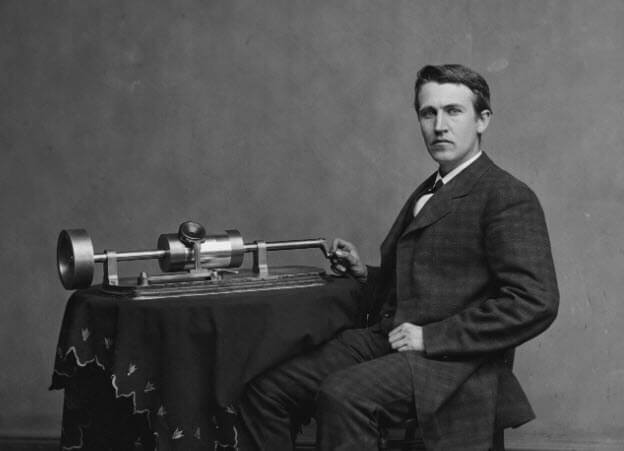What is phonograph? How is phonograph invented? The story of gramophone invention, the history and the inventor.

Source: wikipedia.org
There have been many changes in the gramophone since it was invented in 1877. In that year the first machine for recording and reproducing sound was made by Thomas Edison. A needle was attached to a membrane (skin) stretched across the narrow end of a horn. When he spoke into the horn, his voice made the membrane vibrate. The vibrations caused the needle to make tiny indentations in a piece of tin-foil which he had stretched round a revolving cylinder. The needle was arranged so that it traced a spiral around the cylinder as well as being vibrated to and fro against the tin-foil surface. When the process was reversed and the needle was allowed to move along in the spiral groove, the indentations vibrated the needle and the membrane, and sound was produced through the horn. In a squeaky but distinct voice, the machine repeated the rhyme “Mary had a little lamb“.
In 1886 Bell and Tainter substituted a wax cylinder for the tin-foil and a chisel-shaped cutter for the needle that had made the indentations. They also invented methods of duplicating the records.
In 1887 Emile Berliner substituted a revolving disc for the cylinder (although this idea had previously been thought of by Edison) and arranged for the cutter to make a wavy groove from side to side on the surface instead of indentations up and down into the surface like hills and valleys.
In this way the machine was made to reproduce more accurately the sounds and notes at the bass end of the scale. Berliner also invented improved methods of duplicating the records. His form of groove was known as the “lateral-cut” in contrast with Edison’s “hill-and-dale” groove.
Edison called his machine a “phonograph”. Bell and Tainter called their instrument a “gramophone”. It was Berliner who invented the name “gramophone” for the instrument which played his duplicated records.
During the 40 years after 1887 there were many improvements in the design of the gramophone: clockwork motors (and later electric motors) to turn the disc records at a steady speed; “sound-boxes” to make the membrane and needle more sensitive; different materials for the membrane, which came to be known as the “diaphragm”; a “tone-arm” inserted between the sound-box and the horn and arranged so as to carry the sound-box across the record so that the horn could remain stationary; and improved shapes for the horn.
The next major alteration was made between 1923 and 1927, when what is known as a “pickup” was devised to take the place of the sound-box and to change the mechanical vibrations of the needle into electrical vibrations which could be “amplified” in a valve amplifier in much the same kind of way as are the electrical vibrations picked up from radio broadcasting. These amplified vibrations were then made to produce sound through a loudspeaker.